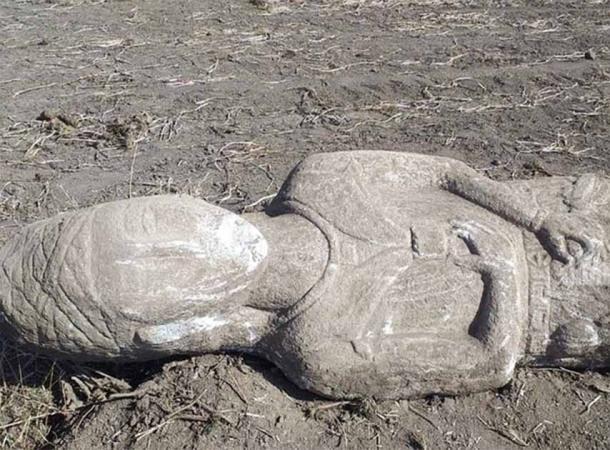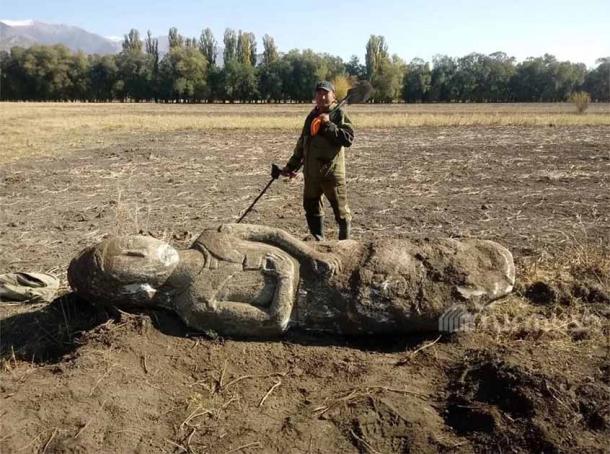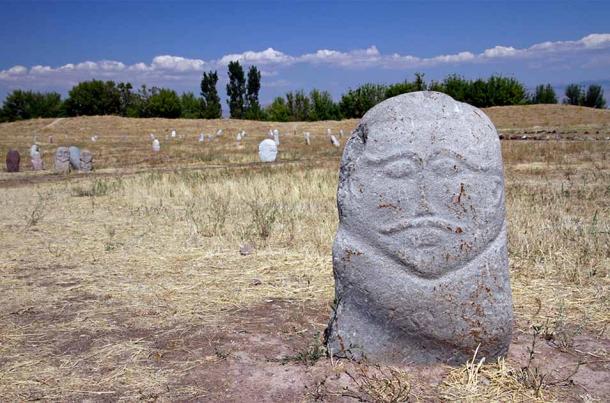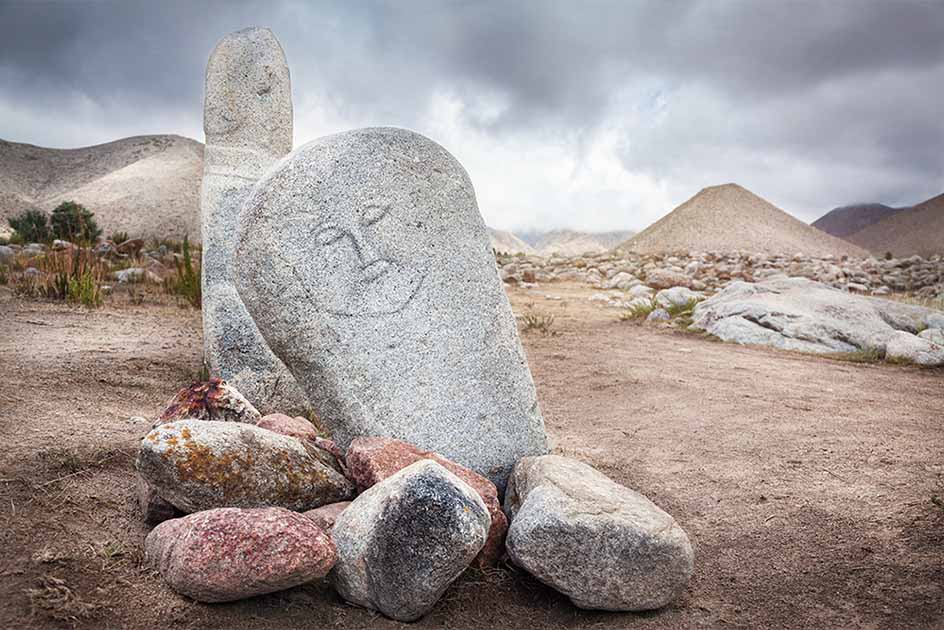Potato Farmer Unearths Huge 6th-Century Balbal Statue in Kyrgyzstan
Many fascinating artifacts and ruins have been uncovered accidentally, particularly during construction projects or by farmers plowing their fields. This pattern has just been repeated in a small Kyrgyzstani village known as Ak-Bulun, where a farmer unexpectedly unearthed an enormous 6th-century Balbal statue.

The balbal statue uncovered in the Lake Issyk-Kul region of Kyrgyzstan.
Discovering the Kyrgyzstani Balbal Statue
On October 15, 2022, a potato farmer named Erkin Turbaev was plowing his land, located in the Lake Issyk-Kul region of the Northern Tian Shan mountains of Eastern Kyrgyzstan, when he suddenly hit something hard. Thinking it was a large rock, Turbaev dug down into the earth intending to remove the troublesome object. After unearthing more of the supposed rock, he was shocked to discover his plow had actually hit a large stone statue that depicted the face and upper body of a human being.
- Dispute Rages as Psychic Warnings See Kyrgyzstan’s Only Mummy Returned to the Earth
- The Eerie Balbal Statues of the Eurasian Steppe
Turbaev soon realized he’d likely discovered an unusually large version of what is known as a balbal. A balbal is a type of memorial statue that was used as a tombstone or grave marker by the first millennium inhabitants of Central Asia, specifically nomadic Turks whose control of the region once extended eastward to what is now the nation of Kyrgyzstan, located on China’s extreme western border.
Aware of the historical significance of this find, Turbaev expressed his excitement over his fortuitous discovery. Speaking with the Kyrgyzstan-based news service AKIpress, he called the massive stone monument “a great historical find for this village.” He also expressed his conviction that the Balbal statue find “will bring good fortune.”

Potato farmer Erkin Turbaev with the recently discovered balbal statue. (Fair Use)
Warrior Balbal Statue Represented a Person of Import
The balbal discovered by Erkin Turbaev was approximately 10 feet (3 m) long. It featured the carved figure of a smooth-faced individual wearing some type of head gear and protective armor. This person, who was presumably male, is portrayed with one arm at his side and the other folded across his stomach.
In the hand of the left (non-folded) arm the stone warrior is holding a short sword, indicating his status as a warrior. The statue is not full-body, but only portrays this unknown individual from the waist up. The bottom half of the statue is uncarved, indicating it was likely buried in the ground.
Historian Zhanbolot Abdykerimov, who studied the newly discovered balbal closely, found inscriptions in the head area and a pendant around the neck. These, combined with the position of the hand folded across the middle, means the person held some important title at the time of his death, according to Abdykerimov’s interpretation.
This is far from the first balbal to be found in Kyrgyzstan. Several of these distinctive statues or tombstones have been found along the lakeshore of Issyk-Kul at other sites, indicating that burials marked by theses monuments were common in the region.

Other stone balbal statues near the Burana Tower in Kyrgyzstan. (lensw0rld / Adobe Stock)
Two Competing Theories of Balbal Origin
Nomadic peoples are not usually associated with stone monuments. They seldom stayed in any place long enough to leave behind any permanent physical ruins. But in the sixth and seventh centuries the Turks adopted burial practices that varied from the usual. They began marking the tombs of honored warriors with skillfully carved balbals, which many speculate were made in the likeness of the departed.
Or at least, that is one theory. Another explanation for balbal-adorned gravesites claims the statues actually represent some of the people the deceased hero vanquished during warfare. The dead enemies of the departed warrior-hero, turned balbal statue, were installed next to the burial site, in order to become his servants in the next world.
If this concept is correct, the individuals depicted on the statue would have represented the best and bravest warriors from among enemy ranks. The deceased individual’s success against them would have been seen as an achievement worth celebrating.
Unforgettable Stone Balbal Statues from a Long-Gone Era
It is currently believed that the balbals found in this area were erected in the sixth century AD, by nomadic Turkish tribes that have been previously identified as the Göktürks. These nomads organized a broad confederation of Turkish peoples in Central Asia in pre-Islamic times, and the presence of the balbals they installed across all the lands they controlled has helped historians determine the territorial borders of this expansive proto-nation-state.
While the Göktürks are the region’s most well-known pre-Islamic people, the lands surrounding Issyk-Kul have actually been occupied for more than 2,000 years. Zhanbolot Abdykerimov points out that many gravesites found in the region date back to far earlier times.
- Burana Tower, Kyrgyzstan’s Ancient and Last Monument to a Lost City
- One More Ancient Civilization Found in Lake Issyk-Kul
“There are historical kurgans (burials) that date back to the 3rd century BC between the settlements of Ak-Bulun and Frunze,” he noted. “There are such kurgans in Fergana and Almaty. There is historical evidence that the ancient city of Sarybulun [the “City of the Red Valley”] was in the eastern part of Issyk-Kul.”
Kyrgyzstan is home to many of the balbals discovered to date. While these anthropomorphic stone stelae were not installed near earlier graves, they proliferated in the immediate pre-Islamic era. Once Islam arrived in the region in the eighth century their construction ceased, but fortunately many of these sturdy stone statues have survived to the present day, providing archaeologists and historians with valuable insights into the culture that produced them.
Top image: Representational image of Balbal statues in Kyrgyzstan. Source: pikoso.kz / Adobe Stock
By Nathan Falde




















Comments
If they find just one in a local vicinity, after digging all around hunting for more, then a good guess that it was used as a solitary marker stone, to designate a boundary of sorts – possibly along a well traveled path. But the question is, how does a relic of that size wind up completely buried in dirt? How many years would it take? Scientists tell us it takes “200-400 years to form 1 cm of soil.” https://www.eniscuola.net/en/argomento/soil/soil-formation/how-long-does...
Nobody gets paid to tell the truth.